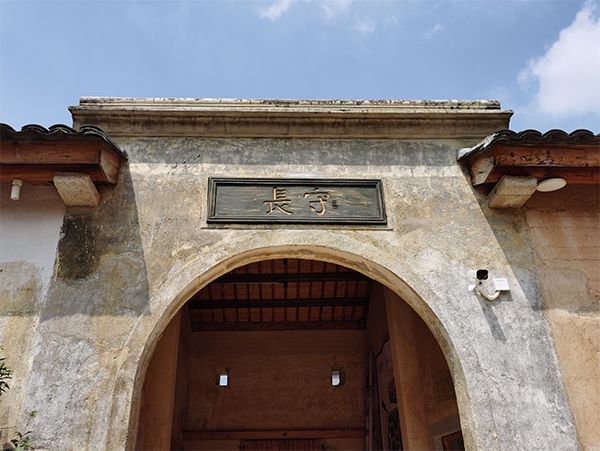 Image Gallery
Image Gallery
Shenzhen Pingshan Changshou Dramaville. Photos by Cao Zhen unless otherwise stated
With a planned area of five hectares, the Shenzhen Pingshan Changshou Dramaville is situated amid verdant surroundings to the northeast of Maluan Mountain, with the Chi’ao Reservoir to the east.
In 2020, Pingshan District began renovating the 300-year-old Jiang family residence in Changshou Village, preserving its original Hakka architectural style while injecting fresh vitality into the old village, transforming it into a venue for high-quality performances.
In June 2023, Pingshan District signed a collaborative agreement with Longma Studio to produce excellent original works, leading to the studio’s establishment in Changshou Village. This move injected theatrical elements and industrial vigor into the area.

The Longma Studio at Shenzhen Pingshan Changshou Dramaville.
The Longma • Changshou Commune, built in the refurbished Jiang’s Hakka residence, covers an area of 7,632.14 square meters. The renovations were executed meticulously to retain the historical allure while crafting a dynamic venue that integrates drama performances, cultural exchanges, and artistic facilities.
Wang Yanxin, the Content Operations Director of Longma Studio, told Shenzhen Daily: “The natural environment surrounding the dramaville fuels our creative endeavors. The Jiang family settled here about 300 years ago, and many stories unfolded ever since. This environment resonates with our theatrical philosophy and aspirations. When Longma Studio Chairwoman Yao Yi and Zhang Guoli visited here four years ago, they felt a profound connection and an ambiance where possibilities could naturally flourish.”

Maluan Mountain is seen in the distance at the dramaville.

Peach blossom decorations are seen at the dramaville.
Founded in 2008 by celebrated playwrights Zou Jingzhi, Liu Heng, and Wan Fang, Longma Studio is known for dramas such as “Break Gold” and “Wotou Guild Hall,” depicting the struggles of ordinary people within their respective eras, said Wang. Apart from the 300-seat theater, other businesses within the dramaville are also intertwined with the theatrical theme.
For example, the restaurant, Bai Xiao Tang, draws its name from “Break Gold,” while the inn in the drama commune features antique furnishings and decor collected globally. Moreover, the outdoor environmental theater allows everyone to enjoy dramas amid the antiquity of the village, accompanied by the scenic backdrop of Maluan Mountain in the distance. By interweaving these businesses and amenities with theatrical elements, this place transcends being merely a tourist spot to become a vibrant drama commune.

The Bai Xiao Tang restaurant at the drama commune.
From the traditional Hakka half-moon pond outside the residence to the inner houses, vintage charm blends with modern elements, with every brick echoing historical grandeur while beckoning future creative endeavors. Architect Zhu Xiaodi has constructed a giant net-weaving installation atop the half-moon pond, providing a serene spot for leisurely strolls or moonlit contemplation for a moment of tranquility.
Wang said that they invited craftsmen adept in traditional mud wall construction skills to imbue the refurbished walls with a retro appeal. The outdoor environmental theater was ingeniously crafted using old walls, creating a space devoid of fixed stages or seats, blurring the lines between actors and audience members, empowering everyone to create and interpret stories.

An aerial view of Longma • Changshou Commune at night. Photo by Liu Xudong

A glance at the library at the drama commune.
In the drama commune’s exhibition hall, an exhibition is showcasing 400 exquisite Shaanxi Huaxian shadow puppets collected by Zhang Guoli, celebrating the legacy of shadow plays and dramas. Another exhibition reviews the 15-year creative journey of Longma Studio through numerous photos, scripts, props, and costumes.
The library houses a large collection of drama-themed books, including contributions from celebrities such as Jackie Chan, Feng Xiaogang, and Joan Chen. In the future, this place will also host book releases and cultural salons.

Zhang Guoli (R) introduces Shaanxi Huaxian shadow puppets at an exhibition Aug. 7. Photo by Liu Xudong

Photos depicting past rehearsals in Longma Studio are on display.
The Shenzhen Pingshan Changshou Dramaville plans to produce one major and two minor theatrical productions annually. Moreover, they will conduct actor training programs and invite acclaimed artists from home and abroad to create, exchange, and perform here.
Through cross-disciplinary collaborations and innovative practices, Pingshan aims to foster the integration and development of drama art with other sectors, offering audience members more high-quality productions.

The environmental theater at the drama commune.

Longma Studio's drama posters are seen at the Hakka coffee shop.
Pingshan District is committed to establishing itself as a theatrical hub in Shenzhen and the Guangdong-Hong Kong-Macao Greater Bay Area. Following years of development, an industrial chain for theater has been implemented.
Notable entities in the district include theater construction company Z&F, theater operator Poly Theater, leading original drama production organization Longma Studio, virtual studio Shenzhen International Movie City, as well as comprehensive arts education facilities like Shenzhen Technology University, and 11 performance venues including the Pingshan Theater.
With the opening of Shenzhen Pingshan Changshou Dramaville, Pingshan is set to further advance the integration of theatrical art with urban development.